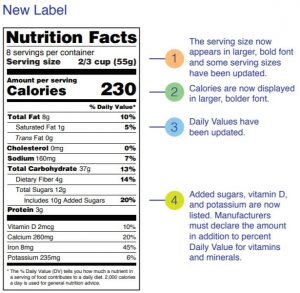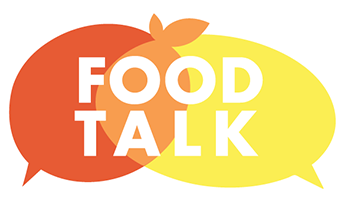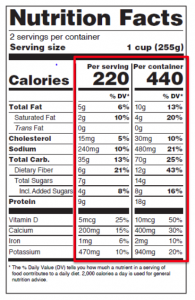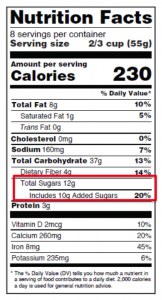You may have noticed changes to the nutrition labels on most foods. We view this label, and the recent changes, as a wonderful tool for us, the consumers, to use when choosing foods to meet our health goals. While there are several updates to the label, two stand out.
Before our standouts, some background. For the first time in 20 years, the U.S. Food and Drug Administration (FDA) has worked through a several year process of changing the nutrition information on food labels. These changes were done to reflect updated scientific information (including links between diet and such chronic diseases as obesity and heart disease) and improve ease of use. American food companies have gradually been changing their nutrition labels to come into compliance. By the start of 2021, all labels must be updated. All this is a win for the consumer. The labels give us control over what foods we buy and put into our bodies.
Check out the new label with some key changes noted.

Now, the two changes that have us most excited. First, the new labels are clearer on the serving size and the number of servings per container. In addition to appearing in large, bold font, serving sizes got updated to reflect what we really eat and drink. (NOTE: The serving size is not a recommendation of how much to eat. It is meant to reflect the amount people typically eat or drink today.) Importantly, for products that are larger than one serving but that a person might consume in one sitting or multiple sittings (think a 24 ounce soda or a pint of ice cream), manufacturers will have to provide “dual column” labels. Similar to the one below.
The second change we are most excited about is the inclusion of “Added Sugars” to the label. There are guidelines in place for how much added sugar we should limit ourselves to a day (no more than 10% of total calories from added sugars per the Dietary Guidelines for Americans. The American Heart Association recommendations are even stricter…no more than 6 teaspoons added sugar per day for women and no more than 10 teaspoons for men). This addition helps you make informed choices based on your individual needs and preferences. Check out this blog and this one for more on added sugars.
In general, the new label is user-friendly and contains most of the information we need when choosing foods. You can pick and choose the parts of the label that mean the most to you. More information about all of the exciting changes to the nutrition label can be found on the FDA website.
Written by Laurel Sanville, MS, RDN, LD ∗ Edited by the UGA SNAP-Ed Nutrition Team




